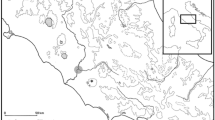Summary
-
1.
Some of the trap features influencing the ability of pitfall traps to catch Coleoptera, especially Carabidae, were investigated by field and laboratory experiments.
-
2.
It is shown theoretically that the catch of circular and rectangular traps can be compared on a basis of their perimeter lengths. Formulae are given for the reduction in catch per trap when traps are placed close together in a grid.
-
3.
Field experiments compared the catch of six types of trap, from 2.5 cm diameter glass tubes, to 2 m long sections of guttering. Glass traps were most efficient in proportion to their size; plastic and metal traps had a reduced catch. Small traps were most efficient in catching small species, whereas large traps caught relatively more large beetles.
-
4.
The capture efficiency of each type of trap was tested in the laboratory, using six species of Carabidae. Traps caught about 75% of beetles that contacted their perimeter; only small traps caught small beetles efficiently; the largest species was caught poorly by nearly all traps.
-
5.
The rate of escape, from each type of trap, of small, medium and large sized Carabidae was tested. Escape was negligible from glass-sided traps, but was about 4% per day from plastic traps, and 10% from metal ones. Large beetles escaped most from small traps, and small beetles from large ones.
-
6.
The observed differences, between types of trap, in capture and retaining efficiencies accounted for some, but not all, of the variations in catch found in the field.
Similar content being viewed by others
References
Ahearn, G. A.: Ecological factors affecting population sampling of desert tenebrionid beetles. Amer. Midl. Nat. 86, 385–406 (1971)
Barlow, C. A.: Phenology and distribution of some Pterostichus (Coleoptera: Carabidae) of eastern Canada. J. N. Y. ent. Soc. 78, 215–236 (1970)
Borg, A.: Forekomsten av carabider i en jordgubbsodling (Col. Carabidae). Ent. Tidskr. 94, 56–58 (1973)
Briggs, J. B.: A comparison of pitfall trapping and soil sampling in assessing populations of two species of ground beetles (Col.: Carabidae). Rep. E. Malling Res. Stn. 1960, 108–112 (1961)
Calkins, C. O., Kirk, V. M.: Distribution and movement of adult false wireworms in a wheat field. Ann. ent. Soc. Amer. 66, 527–532 (1973)
Dempster, J. P.: The control of Pieris rapae with DDT. I. The natural mortality of the young stages of Pieris. J. appl. Ecol. 4, 485–500 (1967)
Greenslade, P., Greenslade, P. J. M.: The use of baits and preservatives in pitfall traps. J. Aust. ent. Soc. 10, 253–260 (1971)
Greenslade, P. J. M.: Pitfall trapping as a method for studying populations of Carabidae (Coleoptera). J. anim. Ecol. 33, 301–310 (1964)
Hinds, W. T., Rickard, W. H.: Correlations between climatological fluctuations and a population of Philolithus densicollis (Horn) (Coleoptera: Tenebrionidae). J. anim. Ecol. 42, 341–351 (1973)
Kudrin, A. I.: K voprosu o tekhnike primeneniya lovchikh banok, obespechivayushei ikh bezrazl ichnost dlya ob'ektov ucheta [in Russian]. Konf. Biots. i Metod. ucheta chslen. Vred. Sel'skoch., Leningrad, p. 46–47, December 7–9 (1971)
Luff, M. L.: The abundance and diversity of the beetle fauna of grass tussocks. J. anim. Ecol. 35, 189–208 (1966)
Luff, M. L.: Some effects of formalin on the numbers of Coleoptera caught in pitfall traps. Entomol. mon. Mag. 104, 115–116 (1968)
Luff, M. L.: The annual activity pattern and life cycle of Pterostichus madidus (F.) (Col. Carabidae). Ent. scand. 4, 259–273 (1973)
Mitchell, B.: Ecology of two carabid beetles, Bembidion lampros (Herbst) and Trechus quadristriatus (Schrank). II. Studies on populations of adults in the field, with special reference to the technique of pitfall trapping. J. anim. Ecol. 32, 377–392 (1963)
Novak, B.: Bindungsgrad der Imagines einiger Feldcarabiden-Arten an die Lebensbedingungen in einem Winterweizenbestand (Col. Carabidae). Acta Univ. Palack. Olomuc. Fac. Rer. Nat. 28, 99–131 (1968)
Obrtel, R.: Number of pitfall traps in relation to the structure of the catch of soil surface Coleoptera. Acta ent. Bohem. 68, 300–309 (1971)
Petruska, F.: K moznosti uniku jednotlivych slozek epigeicke fauny poli z formalinovych zemnich pasti (Coleoptera) [in Czech.]. Acta Univ. Palack. Olomuc. Fac. Rer. Nat. 31, 99–124 (1969)
Author information
Authors and Affiliations
Rights and permissions
About this article
Cite this article
Luff, M.L. Some features influencing the efficiency of pitfall traps. Oecologia 19, 345–357 (1975). https://doi.org/10.1007/BF00348110
Received:
Issue Date:
DOI: https://doi.org/10.1007/BF00348110




